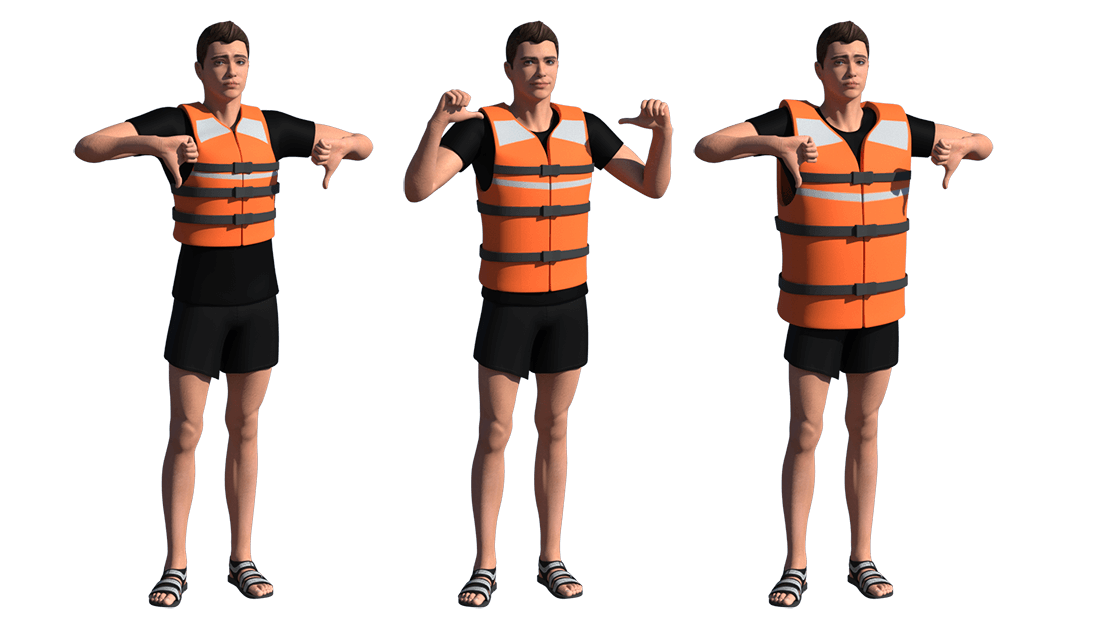Life Jackets (PFD) - Proper Fit

There’s no question that life jackets save lives. However, a life jacket that does not fit properly can put a person at risk of drowning. Proper fit is imperative for safety on the water.
A properly fitted wearable PFD should have which characteristics?
To ensure the proper fit of a PFD, have the wearer put on a PFD and adjust the straps as necessary to ensure a snug fit. Have the wearer raise his or her arms above their head. With his or her arms raised above their head, pull-up firmly on the upper straps of the PFD. A properly fitted PFD will not ride higher than the ears or mouth of the wearer and will keep the head and chin out of the water. Follow the tips below to insure that the PFD you will be wearing is effective.
-
Choose only a USCG approved life jacket of the correct size for the weight of the person. The USCG stamp of approval, size, whether it is for a child or an adult, and appropriate weight of the wearer should be listed inside the jacket on the label. A person’s chest and/or stomach size may come into play when selecting the right life jacket.
-
Use the “touchdown” test to see if your life jacket fits properly. Lift your arms above your head as if calling a “touchdown.” The chest portion of the jacket should not touch your chin when you look left, right or over your shoulder. If the jacket passes this test, it most likely fits. If possible try it out in shallow water. The life jacket should not ride up on your body. However, ride-up may happen if your stomach is larger than your chest.
-
Weigh a child and measure for chest size under the arms before shopping for a child’s life jacket. A properly fitting jacket should be snug but not tight.
-
Check for proper fit of a life jacket on a child. Wearing the jacket, the child should stand normally with arms at his or her sides. Grab the jacket at the shoulders and firmly lift up. The jacket does not fit if it moves more than three inches up and down the child’s body during the test.
-
Ensure a life jacket for an infant or child has a crotch strap to help keep the life jacket on. A good choice for the smaller boaters has an oversized float collar to help keep the head out of the water and a grab loop for easier water rescue. All straps should be intact and fastened at all times.
What is the safest life jacket? In terms of risk of drowning, the safest life jacket is the one you’re willing to wear! There are many good choices to keep you safe on the water. Some of the choices are a better for certain situations than others, and therefore the choices are explained in the "Think Safe" life jacket pamphlet that is sold with every US Coast Guard approved life jacket. By reading the pamphlet, you can understand how to safely have fun on the water.
Note – The fitting procedure above is not applicable to inflatable PFDs. For inflatable PFDs, the retaining strap should be adjusted loosely to allow for the inflation of the device.
Inflatable PFDs
Inflatable PFDs are now available in types I, II, III and V. However, the characteristics of inflatable PFDs are different than inherently buoyant PFDs. Inflatable PFDs are not inherently buoyant and will not float without inflation.

Although inflatable PFDs are considered one of the most comfortable PFDs to wear when it's hot, inflatable PFDs require regular maintenance. It is against the law for a person under 16 to meet the carriage requirements by wearing an inflatable PFD.
When can an inflatable PFD be used?
Inflatable PFDs are not for use when water impact is expected, such as when waterskiing, riding personal watercraft, or whitewater paddling.
An inflatable PFD requires regular maintenance — the owner’s manual should be read and kept as reference. After you have activated your inflatable PFD, replace the CO2 cartridge and re-arm.
What should you do before using an inflatable PFD?
-
The armed indicator is showing green.
-
The inflation cartridge is not cross-threaded (make sure it is screwed in properly to avoid leaks).
-
Check for punctures and wear.
-
Manually inflate the air bladder periodically to insure it is in good condition.
Lack of proper maintenance will render the inflatable PFD useless.
